Undoubtedly, our dogs feel part of the family so it makes great sense to prepare them for the baby’s homecoming just as you would prepare existing children. This is important for both pet and baby’s welfare. Dogs that are properly prepared well in advance usually adjust to the new addition with few problems.
If your dog has never been around babies, it’s a good idea to begin exposing them to the sights, sounds and smells of a newborn BEFORE your little one arrives. By avoiding sudden changes to routine around the time of the birth, you reduce the risk of your pet becoming anxious. Some dogs are worried or even scared by babies so the preparation period focuses on creating positive emotional associations with babies. It can also highlight early warning signs that your dog may be scared of babies and prompt you to seek professional advice.
Often there is more time for dedicated canine cuddles when resting up before the birth. Then baby comes home and suddenly you’re too busy with bub to give your dog as much attention. It’s no longer okay for the dog to jump onto your lap because you have a baby to feed. Reduced predictability and control over social contact can lead to anxiety for your dog which can escalate if the dog has to be relegated to a separate area to allow bub to feed in peace.

Before you have your baby
It’s very important that your dog learns some basic cues before you have your baby. Seek help if necessary to train them to ‘Sit’, ‘Stay’, ‘Come’, ‘Drop it’ and ‘Go to your mat’ on a single calm cue. Use quiet praise to reinforce calm and quiet behaviour or reward them with a yummy chew when they are relaxing.
Try to work on issues like toilet training or having two dogs that play roughly or fight over food, toys or attention well before baby’s due date.
Always use positive reinforcement to encourage desirable behaviours and ignore or redirect undesirable behaviours. A rule of thumb is: think quietly ‘don’t do that’ and say in a cheerfully ‘do this instead’. There is no place for verbal reprimands or other forms of punishment in dog training, particularly around children. Confrontational methods can lead to aggression and children who grow up copying these methods are more at risk of being bitten. Positive training methods are effective for the entire family and
help the relationship between baby and dog to start and remain on a harmonious footing. Good things need to happen whenever baby is around.
Learning to read dog body language
The first step in preparing your dog for your baby, is to learn to read their canine body language as a guide to learning their emotional state.
Are they relaxed and inquisitive? Look for pricked ears, head cocked to the side, sniffing.
Are they uncomfortable? Look for yawning, lip licking, furrowed brow, eyes darting, sideways looks, ears flat to the sides, cowering, backing away, tense posture, shaking, panting, tail tucked or whining.
Are they frightened and at risk of being aggressive? Look for staring, freezing, baring teeth, curling a lip, ears flat back, raised hackles, rigid stance, stiff high tail, barking, growling, snapping or hiding.
The next step is to start to play recordings of baby sounds to your dog, while they are busy doing something they like. Start slowly and softly observing their body language. By playing the sounds at a level that’s comfortable for your dog (observe their body language) and combining this with fun games and positive rewards, your dog can learn a positive association with the sounds and reduce the risk of fear responses when bub comes home.
This process is called ‘desensitisation and counter-conditioning’ and is a way of changing your dog’s emotional response to baby from unsure/scared to feeling okay. A detailed description of such a program to help your dog cope with the sounds (CD included) and touch of a baby can be found in Lewis Kirkham’s book ‘Tell Your Dog You’re Pregnant’. This book also contains many tips to help you and your dog, for example distinguishing dog toys from baby toys and managing attention seeking behaviours like jumping up.

What’s that smell?
Familiarise your dog with new baby items before your baby is born by allowing the dog to sniff and investigate all the new items and smells. Reward desirable responses. Avoid leaving baby items lying around, however, if your dog heads off with a baby item, use the ‘drop it’ cue that you have already trained. When the dog relinquishes the item, replace it with a dog toy or treat. Don’t punish or reprimand your dog. Remember only good things occur in association with baby.
Routine is Key
Big changes in routine like bringing home a new baby can make a dog unsure or anxious. Make your interactions with your dog as consistent and predictable as possible. Cue them to sit for everything they want: food, pats, opening a door for them or clipping on a lead. Have all members of the household on board so your dog knows what to expect in routine situations. This reduces anxiety by giving your dog a sense of control over their environment. They can learn that particular (desirable) behaviours will receive
something nice.
Before baby is born, try to introduce a regular schedule for your dog that you can realistically follow after baby arrives. Keep regular play, walking and feeding schedules. We know you will be less available with your new family commitments but try to schedule two periods of 10 minutes a day when another person is monitoring bub so that you can enjoy this dedicated time with your dog. Talk to them, play with them, pet them. Set a quiet alarm to remind you it’s special doggy time.
Think about ways to smooth out your dog’s experience of you absence for the birth. Do you need to arrange for someone to house sit to avoid your dog becoming stressed by going to another house or boarding and then arriving home to a changed environment? Have a trial run to ensure your dog is comfortable with the arrangement.


